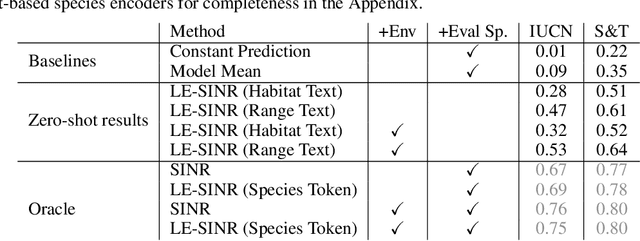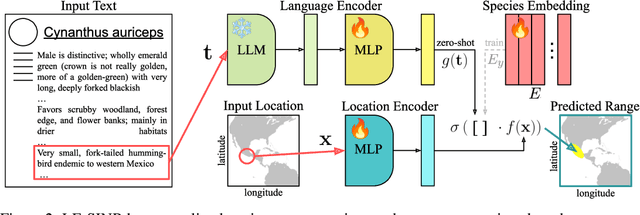Alexander Shepard
Few-shot Species Range Estimation
Feb 20, 2025Abstract:Knowing where a particular species can or cannot be found on Earth is crucial for ecological research and conservation efforts. By mapping the spatial ranges of all species, we would obtain deeper insights into how global biodiversity is affected by climate change and habitat loss. However, accurate range estimates are only available for a relatively small proportion of all known species. For the majority of the remaining species, we often only have a small number of records denoting the spatial locations where they have previously been observed. We outline a new approach for few-shot species range estimation to address the challenge of accurately estimating the range of a species from limited data. During inference, our model takes a set of spatial locations as input, along with optional metadata such as text or an image, and outputs a species encoding that can be used to predict the range of a previously unseen species in feed-forward manner. We validate our method on two challenging benchmarks, where we obtain state-of-the-art range estimation performance, in a fraction of the compute time, compared to recent alternative approaches.
INQUIRE: A Natural World Text-to-Image Retrieval Benchmark
Nov 04, 2024Abstract:We introduce INQUIRE, a text-to-image retrieval benchmark designed to challenge multimodal vision-language models on expert-level queries. INQUIRE includes iNaturalist 2024 (iNat24), a new dataset of five million natural world images, along with 250 expert-level retrieval queries. These queries are paired with all relevant images comprehensively labeled within iNat24, comprising 33,000 total matches. Queries span categories such as species identification, context, behavior, and appearance, emphasizing tasks that require nuanced image understanding and domain expertise. Our benchmark evaluates two core retrieval tasks: (1) INQUIRE-Fullrank, a full dataset ranking task, and (2) INQUIRE-Rerank, a reranking task for refining top-100 retrievals. Detailed evaluation of a range of recent multimodal models demonstrates that INQUIRE poses a significant challenge, with the best models failing to achieve an mAP@50 above 50%. In addition, we show that reranking with more powerful multimodal models can enhance retrieval performance, yet there remains a significant margin for improvement. By focusing on scientifically-motivated ecological challenges, INQUIRE aims to bridge the gap between AI capabilities and the needs of real-world scientific inquiry, encouraging the development of retrieval systems that can assist with accelerating ecological and biodiversity research. Our dataset and code are available at https://inquire-benchmark.github.io
Combining Observational Data and Language for Species Range Estimation
Oct 14, 2024



Abstract:Species range maps (SRMs) are essential tools for research and policy-making in ecology, conservation, and environmental management. However, traditional SRMs rely on the availability of environmental covariates and high-quality species location observation data, both of which can be challenging to obtain due to geographic inaccessibility and resource constraints. We propose a novel approach combining millions of citizen science species observations with textual descriptions from Wikipedia, covering habitat preferences and range descriptions for tens of thousands of species. Our framework maps locations, species, and text descriptions into a common space, facilitating the learning of rich spatial covariates at a global scale and enabling zero-shot range estimation from textual descriptions. Evaluated on held-out species, our zero-shot SRMs significantly outperform baselines and match the performance of SRMs obtained using tens of observations. Our approach also acts as a strong prior when combined with observational data, resulting in more accurate range estimation with less data. We present extensive quantitative and qualitative analyses of the learned representations in the context of range estimation and other spatial tasks, demonstrating the effectiveness of our approach.
Spatial Implicit Neural Representations for Global-Scale Species Mapping
Jun 05, 2023Abstract:Estimating the geographical range of a species from sparse observations is a challenging and important geospatial prediction problem. Given a set of locations where a species has been observed, the goal is to build a model to predict whether the species is present or absent at any location. This problem has a long history in ecology, but traditional methods struggle to take advantage of emerging large-scale crowdsourced datasets which can include tens of millions of records for hundreds of thousands of species. In this work, we use Spatial Implicit Neural Representations (SINRs) to jointly estimate the geographical range of 47k species simultaneously. We find that our approach scales gracefully, making increasingly better predictions as we increase the number of species and the amount of data per species when training. To make this problem accessible to machine learning researchers, we provide four new benchmarks that measure different aspects of species range estimation and spatial representation learning. Using these benchmarks, we demonstrate that noisy and biased crowdsourced data can be combined with implicit neural representations to approximate expert-developed range maps for many species.
 Add to Chrome
Add to Chrome Add to Firefox
Add to Firefox Add to Edge
Add to Edge